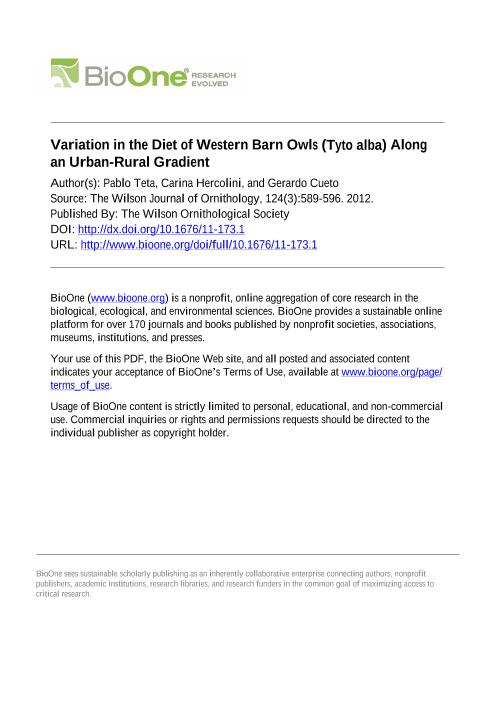Artículo
Variation in the diet of Western Barn Owls (Tyto alba) along an urban-rural gradient
Fecha de publicación:
09/2012
Editorial:
Wilson Ornithological Society
Revista:
Wilson Journal of Ornithology
ISSN:
1559-4491
e-ISSN:
1938-5447
Idioma:
Inglés
Tipo de recurso:
Artículo publicado
Clasificación temática:
Resumen
We studied geographic variation in the diet of Western Barn Owls (Tyto alba) along a urban-rural gradient in central-eastern Argentina and identified 5,231 prey items. Mammals were present in all samples, whereas birds and amphibians were present in 79.1 and 50.0% of the samples, respectively. There were significant differences in vertebrate assemblages consumed by Barn Owls at the opposite extremes of the gradient. Native sigmodontine rodents comprised 85.8 of the total prey items, especially towards periurban and rural areas. Exotic murid rodents were the main prey item in urban sites, while birds increased in frequency in urban and periurban areas. Food niche breadth and standardized food niche breadth values were higher at intermediate levels of urbanization (= periurban). This 'periurban peak' in species diversity is a relatively well-known pattern, previously reported for taxa such as birds, lizards, bumblebees, and butterflies among others. The trophic habits of Barn Owls along this gradient were mostly similar to those reported in other studies in southern South America, where the main prey items were native rodents and food niche breadth values (measured at the level of Orders) were low. Western Barn Owls in our study maintained specialization as a micromammal predator.
Palabras clave:
Diet
,
Tyto Alba
,
Urban
,
Gradient
Archivos asociados
Licencia
Identificadores
Colecciones
Articulos(CCT-CENPAT)
Articulos de CTRO.CIENTIFICO TECNOL.CONICET - CENPAT
Articulos de CTRO.CIENTIFICO TECNOL.CONICET - CENPAT
Articulos(IEGEBA)
Articulos de INSTITUTO DE ECOLOGIA, GENETICA Y EVOLUCION DE BS. AS
Articulos de INSTITUTO DE ECOLOGIA, GENETICA Y EVOLUCION DE BS. AS
Citación
Teta, Pablo Vicente; Hercolini, Carina Belén; Cueto, Gerardo Ruben; Variation in the diet of Western Barn Owls (Tyto alba) along an urban-rural gradient; Wilson Ornithological Society; Wilson Journal of Ornithology; 124; 3; 9-2012; 589-596
Compartir
Altmétricas




